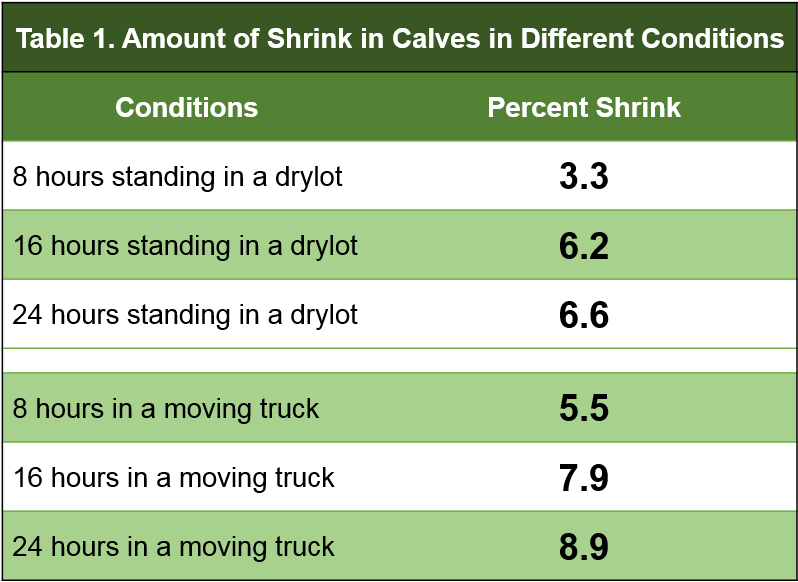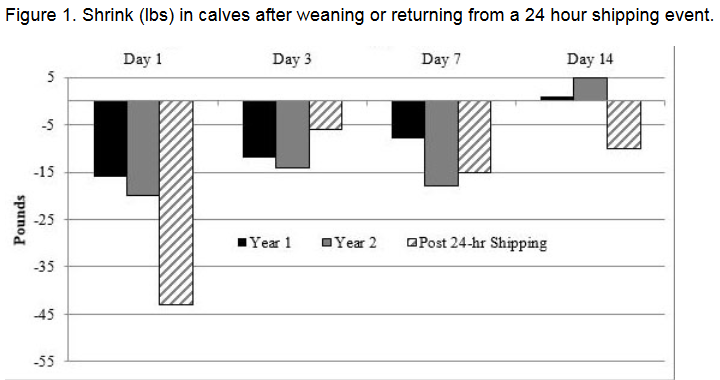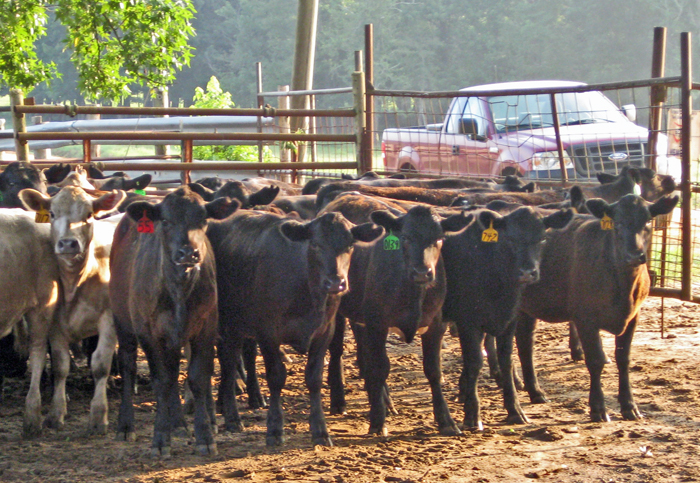Perhaps weaning time has come and gone on your operation, but did you consider how much potential profit was lost because of shrink in the calves you sold? Shrink in beef calves is weight loss due to stress that occurs from the time an animal leaves one location and is weighed at another. Shrinkage can’t be completely avoided, but it can certainly be managed and minimized. Several factors cause shrink, but primarily withholding feed and water or exposure to stress have the greatest effect.
How Does Shrink Occur
 Shrink in calves occurs walking from the pasture to the working facilities, hauling calves from the pasture to the sale barn, or the ranch to the feedlot. Those examples demonstrate the factors of handling stress, travel, time, and food/water deprivation on shrink. The amount of shrink a calf experiences increases as the number and duration of the stressors increased. Table 1, above, shows the results of a study that examined how different handling and time affects the percent shrink in feeder calves. Shrink increases with time and the severity of the stress. Figure 1, below, shows the amount of body weight lost from calves at weaning in a two year study. Additionally, in one year cattle were backgrounded for 50 days and transported for 1,000 miles over a 24-h shipping event. These calves were born and weaned in Florida. After weaning, the amount of shrink in one day amounted to 3.5 and 3.9%, similar to the amount of shrink after 8-hours of standing in a drylot. Calves did not regain their off-pasture weaning weight until 14 days later. So not only was the shrink associated with a change in diet, but with handling, change in environment, and loss of tissue from stress. After a shipping event, these calves were unable to regain the lost body weight within 14 days, despite adequate access to hay, supplement, and water. The amount of shrink was greater because feed and water removal was coupled with the stress of transit. The severity of shrink varies within a group of calves, but managing shrink has implications on the group’s health and profit potential.
Shrink in calves occurs walking from the pasture to the working facilities, hauling calves from the pasture to the sale barn, or the ranch to the feedlot. Those examples demonstrate the factors of handling stress, travel, time, and food/water deprivation on shrink. The amount of shrink a calf experiences increases as the number and duration of the stressors increased. Table 1, above, shows the results of a study that examined how different handling and time affects the percent shrink in feeder calves. Shrink increases with time and the severity of the stress. Figure 1, below, shows the amount of body weight lost from calves at weaning in a two year study. Additionally, in one year cattle were backgrounded for 50 days and transported for 1,000 miles over a 24-h shipping event. These calves were born and weaned in Florida. After weaning, the amount of shrink in one day amounted to 3.5 and 3.9%, similar to the amount of shrink after 8-hours of standing in a drylot. Calves did not regain their off-pasture weaning weight until 14 days later. So not only was the shrink associated with a change in diet, but with handling, change in environment, and loss of tissue from stress. After a shipping event, these calves were unable to regain the lost body weight within 14 days, despite adequate access to hay, supplement, and water. The amount of shrink was greater because feed and water removal was coupled with the stress of transit. The severity of shrink varies within a group of calves, but managing shrink has implications on the group’s health and profit potential.
Other Factors Affecting Shrink
- Transportation time. Studies have demonstrated that calves will shrink about 1% per hour for the first 3 to 4 hours, then ¼% for the next 8 to 10 hours. Table 1 indicates that 8 hours in transit can result in over 5% shrink and increasing up to 8% at 16 hours and almost 9% at 24 hours of transit. Many calves leaving Florida and the Gulf Coast Region can experience a 24 hour shipping event to reach their next destination in the Southern Plains or Texas.
- Amount of fill. The diet that cattle are consuming can affect the amount of fill and subsequent shrink experienced. Diets low in dry matter and high in moisture result in a greater shrinkage, whereas dryer diets create less shrink, or slower weight loss.
- Condition/Weight. Cattle that are fatter tend to shrink less than cattle that have less body fat. Fat contains less water than lean muscle tissue, so less metabolic-tissue water is lost to shrink.
- Season. Higher temperatures induce a greater stress response in cattle and thus a greater shrink response. When temperatures are high, cattle lose more metabolic water through heavy breathing and greater maintenance energy expenditure than during cool temperatures
- Handling procedures. Cattle shrink less when they are handled in a quiet manner using good Beef Quality Assurance handling practices.
Calf Price and Shrink
The outward appearance of the calves at market can affect the price received. Arkansas data indicates that buyers adjust the price per pound based on an estimate of shrink to follow the purchase. Gaunt and shrunk cattle received $3 to $8 greater sale prices compared to average fill calves. In contrast, calves that were full or very full were discounted $3 to $24 from the base selling price received by average fill calves. UF/IFAS EDIS document AN322 Shrink in Beef Cattle a Marketing Consideration details the relationship of calf shrink and price to the seller and the buyer.
Summary
Shrink in cattle occurs often with detrimental economic impacts. The cattle owner can mitigate some causes for shrink at the ranch of origin, through timing of marketing, and animal handling techniques. Not considering shrink and the potential outcomes during the marketing process jeopardizes the optimum price point for both the buyer and seller.
Other articles and publications related to this topic:
Shrink in Beef Cattle a Marketing Consideration
How Important is Shrink In Beef Calves
Managing Cattle “Shrink” at Shipping to Increase Profits
BQA On-Farm Training Manual
- Clemson Virtual Southeast Cow-Calf Conference – November 11-12 - November 6, 2020
- Dispelling Cattle Mineral Supplementation Myths - November 15, 2019
- What Influences Profit for the Beef Cattle Enterprise? - June 3, 2019

